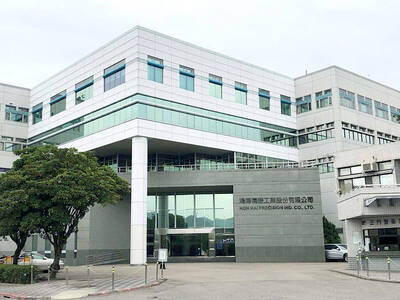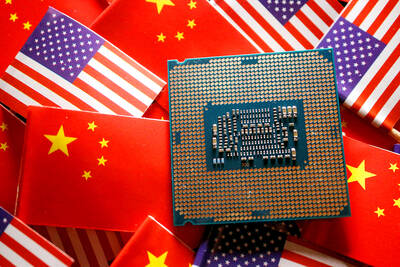Powerchip Semiconductor Manufacturing Corp (力積電) yesterday held a groundbreaking ceremony for a NT$278 billion (US$9.72 billion) fab in Miaoli County, to raise capacity as it is struggling to keep up with demand for its chips.
Chip shortages earlier this year suspended operations at some vehicle factories and forced some smartphone makers to phase out lower-end models ahead of schedule.
“All our product lines are fully utilized. We expect that the situation will last through the end of next year at least. So we have to build a new fab,” Powerchip chairman Frank Huang (黃崇仁) said on the sidelines of the ceremony.

Photo: Bloomberg
The severe shortage has led to an increase in chip prices of 30 to 40 percent since the end of last year, Huang said, adding that he expects that prices would increase further, with a new wave of hikes as early as next month.
“I have been working in the semiconductor industry for a long time, but I have never seen any structural shortage like this before,” he said.
The supply-demand disparity comes as almost no investment has over the past few years been made by the world’s major chipmakers in certain high-demand segments, Huang said.
While major chipmakers have invested in advanced technologies, such as 3-nanometer technology developed by Taiwan Semiconductor Manufacturing Co (台積電), they did not invest in less advanced technologies, which are also used in electric vehicles, Internet-of-Things equipment and 5G devices, he said.
Powerchip’s new fab in the Tongluo Science Park (銅鑼科學園區) would from 2023 make chips with 45-nanometer and 50-nanometer technologies, Huang said.
Management ICs, touch sensors, vehicle chips and driver ICs for flat panels would be made at the new fab, he said.
In its first phase, the fab would produce 25,000 12-inch wafers per month, before capacity would be raised to 100,000 wafers per month, Powerchip said.
The fab would create 3,000 new jobs and, when fully utilized, generate NT$60 billion in production value, it said.
Huang said that Taiwan offers the most competitive environment for semiconductor firms, with production costs lower than in other countries, including China.
“For decades, Taiwan has been a trusted manufacturer of semiconductors,” American Institute in Taiwan Director Brent Christensen said at the ceremony.
President Tsai Ing-wen (蔡英文) has identified the semiconductor industry as a strategic priority, not only for economic innovation, but also for national security, Christensen said, adding that the US government agrees with that view.
Last month, as one of his first executive orders, US President Joe Biden launched a review process of supply chains for critical and essential goods to make them more resilient and safe, Christensen said.
Building resilience for the US means increasing domestic production of certain equipment, he said.
However, that would also entail closer cooperation with trusted partners that share the same values as the US, Christensen said, adding that this would ensure that supply chain access cannot be leveraged against the US.
To forge stronger economic ties with Taiwan, as well as ties in fields of cooperation, the two nations last year launched the US-Taiwan Economic Prosperity Partnership Dialogue, Christensen said.
The dialogue is part of a broader coalition to counter China’s unfair economic and investment policies, he said.
Christensen also encouraged investment from Taiwanese semiconductors companies across the entire value chain — design, foundries, assembly and supply.

Shares in Taiwan closed at a new high yesterday, the first trading day of the new year, as contract chipmaker Taiwan Semiconductor Manufacturing Co (TSMC, 台積電) continued to break records amid an artificial intelligence (AI) boom, dealers said. The TAIEX closed up 386.21 points, or 1.33 percent, at 29,349.81, with turnover totaling NT$648.844 billion (US$20.65 billion). “Judging from a stronger Taiwan dollar against the US dollar, I think foreign institutional investors returned from the holidays and brought funds into the local market,” Concord Securities Co (康和證券) analyst Kerry Huang (黃志祺) said. “Foreign investors just rebuilt their positions with TSMC as their top target,

REVENUE PERFORMANCE: Cloud and network products, and electronic components saw strong increases, while smart consumer electronics and computing products fell Hon Hai Precision Industry Co (鴻海精密) yesterday posted 26.51 percent quarterly growth in revenue for last quarter to NT$2.6 trillion (US$82.44 billion), the strongest on record for the period and above expectations, but the company forecast a slight revenue dip this quarter due to seasonal factors. On an annual basis, revenue last quarter grew 22.07 percent, the company said. Analysts on average estimated about NT$2.4 trillion increase. Hon Hai, which assembles servers for Nvidia Corp and iPhones for Apple Inc, is expanding its capacity in the US, adding artificial intelligence (AI) server production in Wisconsin and Texas, where it operates established campuses. This

US President Donald Trump on Friday blocked US photonics firm HieFo Corp’s US$3 million acquisition of assets in New Jersey-based aerospace and defense specialist Emcore Corp, citing national security and China-related concerns. In an order released by the White House, Trump said HieFo was “controlled by a citizen of the People’s Republic of China” and that its 2024 acquisition of Emcore’s businesses led the US president to believe that it might “take action that threatens to impair the national security of the United States.” The order did not name the person or detail Trump’s concerns. “The Transaction is hereby prohibited,”

Garment maker Makalot Industrial Co (聚陽) yesterday reported lower-than-expected fourth-quarter revenue of NT$7.93 billion (US$251.44 million), down 9.48 percent from NT$8.76 billion a year earlier. On a quarterly basis, revenue fell 10.83 percent from NT$8.89 billion, company data showed. The figure was also lower than market expectations of NT$8.05 billion, according to data compiled by Yuanta Securities Investment and Consulting Co (元大投顧), which had projected NT$8.22 billion. Makalot’s revenue this quarter would likely increase by a mid-teens percentage as the industry is entering its high season, Yuanta said. Overall, Makalot’s revenue last year totaled NT$34.43 billion, down 3.08 percent from its record NT$35.52